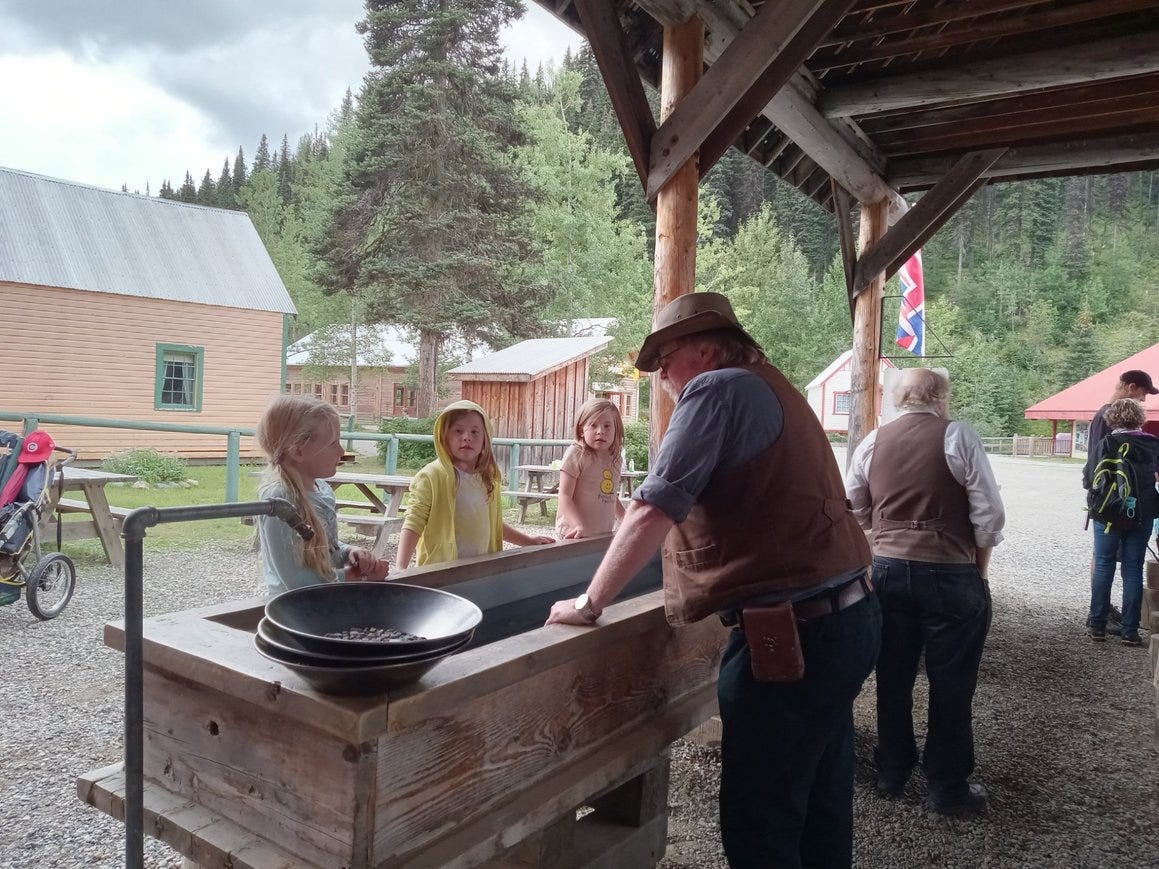Welcome to the NORTHERN HERITAGE Newsletter # 16 and thank you for joining our journey of discovery into the heritage of Prince George and Northern BC.
On a personal note, I have finished running my UNBC course and have more-or-less returned to the land of the living just in time for the glorious Prince George summer!
It’s summertime and Barkerville is open for panning for gold!
The Background of Heritage Planning in Prince George
In March I wrote a piece about How Heritage Works in Prince George, in which I referred to the two main ‘heritage management’ documents for Prince George: the City of Prince George Heritage Strategic Plan 2006 (Donald Luxton & Associates) and the Prince George Heritage Context Study: a Report to Guide the Development of the Community’s Heritage Planning Program (Heritage Branch 2010). The Heritage Strategic Plan aims to:
provide a focus for the development and management of a community-based heritage program…. It seeks to promote a shared vision for community conservation efforts. (Heritage Strategic Plan, pg. 3)
The Heritage Context Study, expands on this by identifying some of the significant aspects of history that shaped the modern city, allowing the history and heritage of this place to contribute to the shaping of its future. It aims to provide information and recommendations to guide the development of a values-centred heritage conservation planning program in Prince George.
The City of Prince George can use the information in this document to guide the development of its community heritage planning program. (Heritage Context Study, pg. 49)
So what exactly is a “community heritage planning program (CHPP)”? does Prince George have one? and, if not, what progress has been made so far in formulating one?
What is a Community Heritage Planning program?
Community heritage planning is the process of deciding how best to manage the heritage which the community has identified as having value and meaning to them. According to Heritage BC:
Heritage planning helps communities decide how to manage that inheritance. In most cases, local governments manage heritage initiatives through their planning departments (
A successful program needs to address a number of basic issues:
What heritage and what about that heritage needs to be safeguarded? How to manage and safeguard these individual heritage resources - meeting individual needs?
How to manage heritage as a whole facing the realities of the 21st century- meeting shared community needs and playing a role?
How and when should we carry out conservation and maintenance? How to monitor the impacts of inevitable change over time?
What are all the actions needed to address these issues, who is responsible for what and how do we pay for it?
What are the most effective ways to inform and engage the community in this whole process?
What does a CHPP look like? Where are we in the process?
Starting with acquiring an understanding of current needs, setting strategic goals or a vision of where the community would like to go, and then developing the necessary steps to get there…. a basic CHPP should look something like this:
a) You cannot plan for heritage until you know exactly what you’re planning for
What is sorely lacking is a clear understanding of what heritage exists in Prince George, its physical condition and potential, what it needs to survive and play a role in the community and what stories it can tell. This is the First Step and requires:
A Situational Analysis study to clarify exactly what the current status of heritage safeguarding in Prince George is and to highlight strengths and weaknesses, threats and opportunities.
An Inventory Update based on a community outreach program of discussion and stakeholder involvement - a wide-reaching and inclusive Inventory is the source of options and inspiration for telling meaningful stories about the city
b) You cannot plan for heritage until you have an encompassing vision of how this heritage should be functioning in the community, economically, culturally, socially and educationally
So Step Two is a clear Vision Statement that states where the community of Prince George sees the status and use of its heritage in the future; what role do we see heritage playing in the community? The Official Community Plan has a Vision Statement for Prince George but not for
As we enter a new urban era, we should regard culture as a powerful ally in our efforts to address key global challenges, from the financial and refugee crises to climate change, poverty and inequality worldwide….he need to integrate the different disciplines for the analysis and planning of the urban conservation process in order not to separate it from the planning and development of the contemporary city (Van Oers 2015 in my May 2 newsletter on the Historic Urban Landscape)
c) You cannot plan for heritage without goals, a method and an appropriate toolbox, and clear priorities and actions
There is a clearly stated commitment to heritage and appreciation of its value in the revised Official Community Plan; everyone seems to agree that heritage contributes to the City and should be ‘saved for future generations’. But - and I guess this is the point of this newsletter - we can’t jump from a general commitment to decision making about individual heritage resources or heritage as a whole without the critical intervening steps!
So Step 3 is a strategy for application of Heritage Management Tools:
Tools that are already available to the City such as adding heritage to the Heritage Register, Designating items of particular value to the community and rethinking the use of Conservation Areas and heritage zones.
A detailed and future-looking plan for developing additional Heritage Management Tools that are fundamental to the success of the safeguarding process such as Conservation Guidelines for specific forms of heritage; Homeowner Manuals with guidance on how people can look after their historic houses; Monitoring and Maintenance programs and the critically important tool - Heritage Impact Assessments - to ensure that valuable heritage places, activities and properties are not missed in the planning process and lost to development and change.
d) You cannot plan for heritage without the support and involvement of an informed public
Step 4 is an Education Plan for schools, colleges, the wider community and also in the form of Capacity Building for those in positions of responsibility for decision making and implementing heritage safeguarding in Prince George
It also includes a plan for Interpretation and Story-Telling to bring the city’s heritage alive - stories about the indigenous owners of the land, the arrival of immigrants from around the world, the growth of industry, railways and roads, arts and culture, education and more. This should be tied to a Communication Scheme and Tourism Proposals to reach out beyond Prince George
e) Lastly, you cannot plan for heritage without funding—
So Step 5 has to be the Development of a Heritage Fund and Financing Package based on adaptive re-use of heritage places; support and marketing of heritage skills, crafts and knowledge; public-private partnerships; heritage tourism and giving all forms of heritage an active role in the Prince George community.
Who does all this work?
In most BC cities and communities these components of a CHPP are instigated and carried out under the auspices of the City Planning Department with the assistance of the city’s Community Heritage Commission:
For it to best succeed, heritage planning should be integrated within the overall community or regional planning system. In community heritage planning, as in community planning generally, this usually falls to local government. Its overall role will of course vary from one community to another, but in general terms, it will be to coordinate and facilitate the process, to encourage community involvement, and to ensure community consensus. (Heritage Planning: A Guide for Local Government, BC Government 1992)
This is where the whole issue turns murky… I admit that I am still new to the Canadian system of heritage management but my understanding is that, working under the BC Heritage Conservation Act and the Community Charter, the City of Prince George relies on its Planning Department and the Community Heritage Commission (under Bylaw 8133, 2008) for all things related to heritage.
The CHC conducts its business with the assistance of legislative support staff (an officer of the Planning Department appointed by the corporate officer) and a city staff liaison appointed by the city manager. The Commission reports to and passes on recommendations to the Mayor and Council. Currently, the CHC can propose and plan steps towards a CHPP but mechanisms for moving proposals forward and getting them activated are still unclear. The Commission can meet only four times a year and has very limited access to funding.
Unlike some other cities in BC, such as Victoria, Nelson, Surrey and Burnaby, there is no dedicated Heritage Planner within the Prince George Planning Department which handicaps progress in heritage management.
What next?
The Official Community Plan says that:
Heritage planning and resource management is necessary to ensure the unique traits and features that give our community a distinctive quality and appearance are not lost (Official Community Plan p. 75)
It also states that:
the City should work with the community to establish a heritage conservation program that should strive to protect, through a balance of incentives and regulations, significant examples of our heritage. This program should recognize the the public benefits of preserving tangible links to our historical development and raise awareness of the value of heritage to our community (Official Community Plan p. 29)
The next NORTHERN HERITAGE newsletter will look more closely at the Official Community Plan and how it contributes to a Community Heritage Planning Program for Prince George…..










